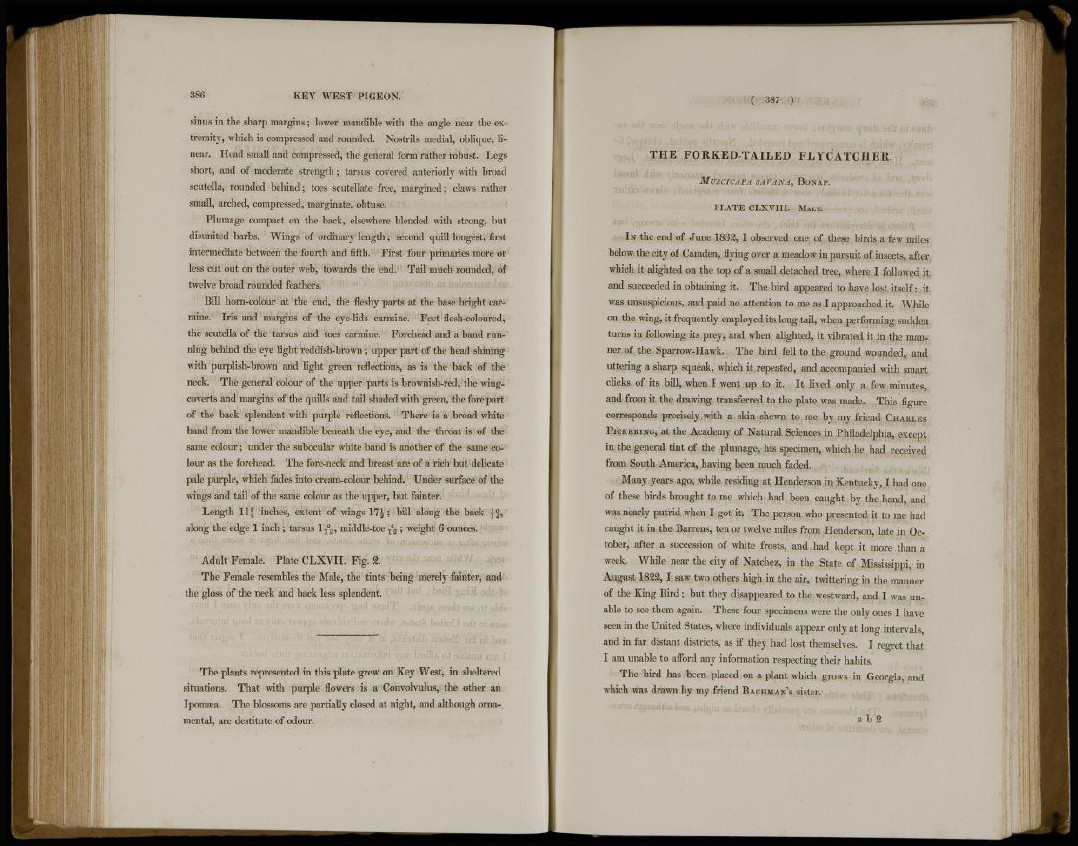
386 KEY WEST PIGEON.
sinus in the sharp margins; lower mandible with the angle near the extremity,
which is compressed and rounded. Nostrils medial, oblique, linear.
Head small and compressed, the general form rather robust. Legs
short, and of moderate strength; tarsus covered anteriorly with broad
scutella, rounded behind; toes scutellate free, margined; claws rather
small, arched, compressed, marginate, obtuse.
Plumage compact on the back, elsewhere blended with strong, but
disunited barbs. Wings of ordinary length; second quill longest, first
intermediate between the fourth and fifth. First four primaries more or
less cut out on the outer web, towards the end. Tail much rounded, of
twelve broad rounded feathers.
Bill horn-colour at the end, the fleshy parts at the base bright carmine.
Iris and margins of the eye-fids carmine. Feet flesh-coloured,
the scutella of the tarsus and toes carmine. Forehead and a band running
behind the eye light reddish-brown ; upper part of the head shining
with purplish-brown and light green reflections, as is the back of the
neck. The general colour of the upper parts is brownish-red, the wingcoverts
and margins of the quills and tail shaded with green, the fore part
of the back splendent with purple reflections. There is a broad white
band from the lower mandible beneath the eye, and the throat is of the
same colour; under the subocular white band is another of the same colour
as the forehead. The fore-neck and breast are of a rich but delicate
pale purple, which fades into cream-colour behind. Under surface of the
wings and tail of the same colour as the upper, but fainter.
Length l l f inches, extent of wings 1 7 £ ; bill along the back
along the edge 1 inch ; tarsus l T
2
g , middle-toe T
4
5 ; weight 6 ounces.
Adult Female. Plate CLXVII. Fig. 2 .
The Female resembles the Male, the tints being merely fainter, and
the gloss of the neck and back less splendent.
The plants represented in this plate grew on Key West, in sheltered
situations. That with purple flowers is a Convolvulus, the other an
IpomEea. The blossoms are partially closed at night, and although ornamental,
are destitute of odour.
( 387 )
THE FORKED-TAILED FLYCATCHER.
MUSCICAPA SA VAN A, BoNAP.
PLATE CLXVII I. MALE.
I N the end of June 1 8 3 2 , I observed one of these birds a few miles
below the city of Camden, flying over a meadow in pursuit of insects, after
which it alighted on the top of a small detached tree, where I followed it
and succeeded in obtaining it. The bird appeared to have lost itself: it
was unsuspicious, and paid no attention to me as I approached it. While
on the wing, it frequently employed its long tail, when performing sudden
turns in following its prey, and when alighted, it vibrated it in the manner
of the Sparrow-Hawk. The bird fell to the ground wounded, and
uttering a sharp squeak, which it repeated, and accompanied with smart
clicks of its bill, when I went up to it. It lived only a few minutes,
and from it the drawing transferred to the plate was made. This figure
corresponds precisely with a skin shewn to me by my friend CHARLES
PICKERING, at the Academy of Natural Sciences in Philadelphia, except
in the general tint of the plumage, his specimen, which he had received
from South America, having been much faded.
Many years ago, while residing at Henderson in Kentucky, I had one
of these birds brought to me which had been caught by the hand, and
was nearly putrid when I got it. The person who presented it to me had
caught it in the Barrens, ten or twelve miles from Henderson, late in October,
after a succession of white frosts, and had kept it more than a
week. While near the city of Natchez, in the State of Mississippi, in
August 1 8 2 2 , I saw two others high in the air, twittering in the manner
of the King Bird; but they disappeared to the westward, and I was unable
to see them again. These four specimens were the only ones I have
seen in the United States, where individuals appear only at long intervals,
and in far distant districts, as if they had lost themselves. I regret that
I am unable to afford any information respecting their habits.
The bird has been placed on a plant which grows in Georgia, and
which was drawn by my friend BACHMAN'S sister.
B b 2